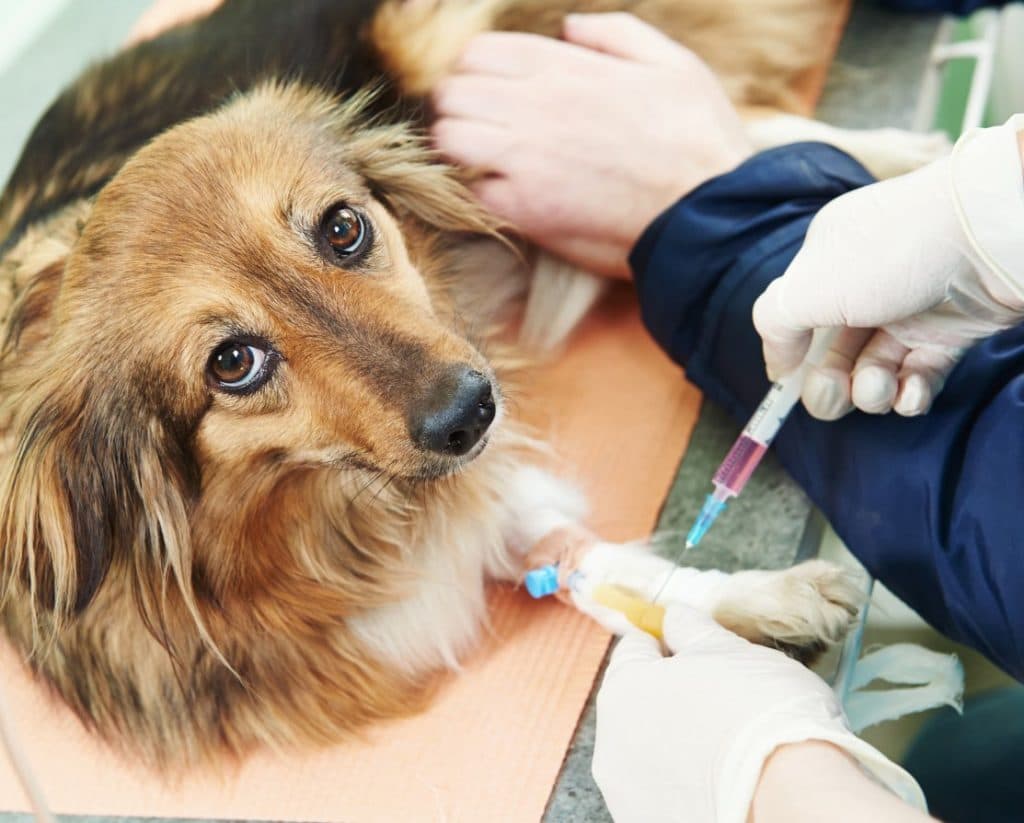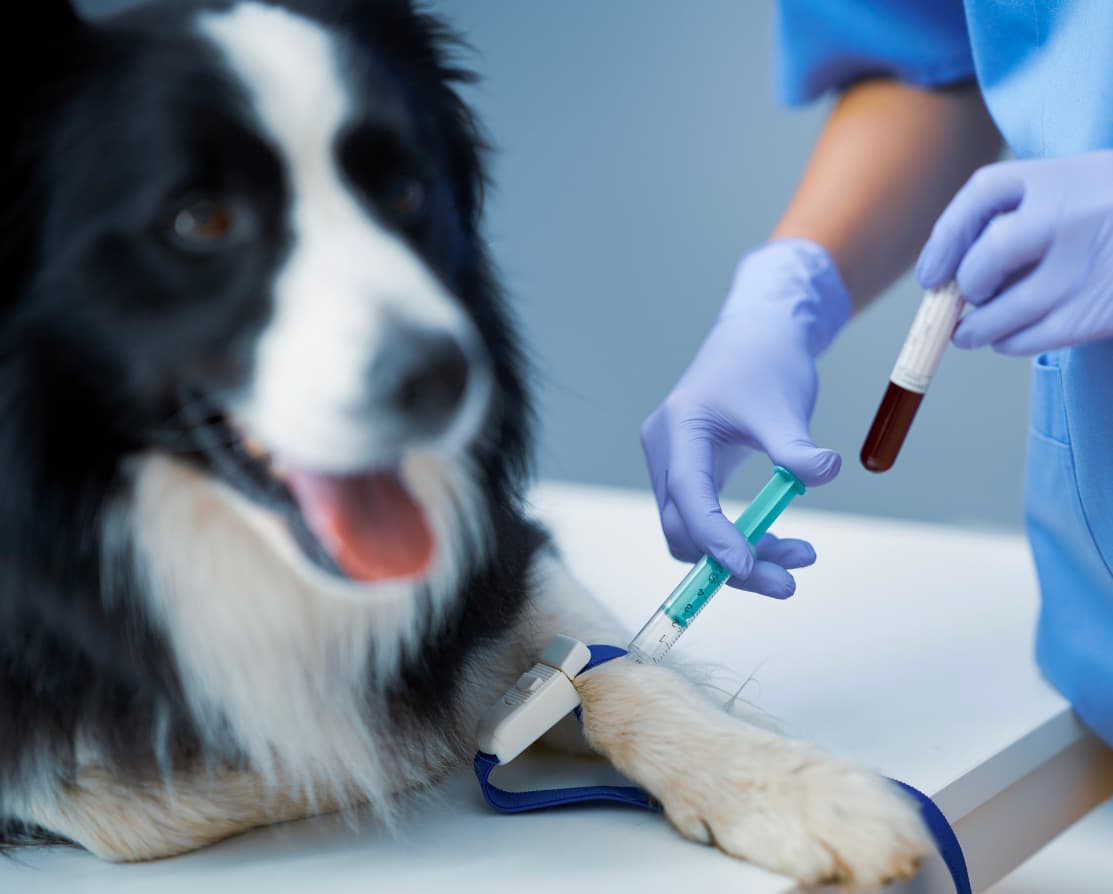
When your family doctor suggests you need blood work, you may dread the wait at the blood lab and the looming poke in your arm. However, you don’t consider any financial implications as all you need to do in Ontario is produce your health card. When you take your pet to the veterinarian, and they suggest blood work, you are now responsible for the cost, and so you may wonder why you need to bother if your pet just had blood work last year. Pet insurance can possibly save you from that worry, but that’s a topic for another blog.
I want to talk about the importance of blood work for pets and why your veterinarian may recommend it. A doctor can learn a great deal from analyzing blood which is why if you’ve ever spent some time in the hospital, you know they take your blood almost daily. Looking for changes or trends in bloodwork can give medical personnel vital information to move forward with a patient’s care, either human or animal. While your veterinarian can tell you a lot about your pet’s bloodwork, as a pet wellness advocate, you can also get involved in understanding the results so that you can make a difference in helping to keep your pet healthy.
In this article, I’d like to recommend various circumstances when you might need to have your pet’s blood taken, what you need to know about your pet's blood results and what you can do with that information. I’m going to comment on some of the new tests available today and, most importantly, how you can be involved in making blood testing as fear-free as possible for your pet.
Many pet parents have experienced a panicked visit to the veterinarian when their pet is ill.
This is a crucial time to take blood from your pet because blood runs through every important part of your pet's body. It starts with every organ, like the skin, liver, kidneys, heart, brain, and goes to the bones and the muscles. If there's anything wrong with your pet's body, blood work is likely to uncover it. If your pet needs surgery, it’s imperative to do pre-anesthetic blood work.
When your pet isn’t ill, the urgency is now gone, and some of my clients have asked, “Why would we want to take blood work from a perfectly healthy six-month-old puppy or kitten?”.
There are two reasons. The first is to get a baseline on the puppy or kitten. And what I mean by that is when you take blood from any animal, there's a reference range. For example, there's a liver enzyme where the reference range is 10 to 100. That means they took a large number of “normal” animals, drew blood, and found that the lowest was 10, the highest was 100, and every other animal was in between those values. We need a baseline from a puppy to see where that puppy falls within that baseline when they're “normal.” If we took blood when that puppy was now an adult dog, at seven years of age and not well, we could compare those results to when they were younger and compare apples to apples.
Another opportunity to test your pet’s blood is one you may not have thought of or dismissed as unnecessary or too expensive. That would be for a wellness blood profile.
This form of blood testing has become a lot more popular in the last decade as both veterinarians and owners are starting to realize how vital blood work for pets is in diagnosing diseases before clinical signs appear. Many veterinarians start recommending wellness testing when a pet is middle-aged, somewhere in the five-to-eight-year range, and then we usually test them every year after that. For dogs, it's much more routine than for cats, because we typically test dogs every year for things like heartworm disease (if you’re interested, the American Heartworm Society has some important info on the subject).

In a word: no.
It's optional. However, it’s recommended for two reasons. Number one, dogs and cats don't live as long as humans, so when you're testing them every year, you're really testing them the equivalent of every five to seven human years. This sounds more reasonable, right? Number two, the key to wellness testing is trending results. The more often we test, the easier it is to pick up trends.
As a pet owner, you can actually help your veterinarian by learning about what your pet’s blood results mean. Here’s an example of changes that you may see from one test to the next. Think back to that liver enzyme I mentioned earlier, where the typical values are 10 to 100. Let's imagine that you take your little kitty in for some blood work at seven years of age, and the value is 20, and then a year later, you rerun blood, and now it's 90. Your veterinarian will tell you it's normal, which it is because the reference range is 10 to 100.
However, that reference range is for every other cat. Your cat was once 20 and is now 90. That's something that I think that we shouldn't ignore. You can make your veterinarian aware of a trend if you notice a trend. To be honest, when you're a veterinarian in practice, and you have a few hundred other clients, and you see a typical blood result, there’s little reason to look back a year earlier to see what the blood result was. If the result is abnormal, your veterinarian will definitely look back, but not if it's normal.
This is why I encourage all my clients to take their blood results home with them, and this way, they can keep track of their pet's blood trends. In my mind, it's no different than monitoring your bank account. We can't expect banks to give us a call and say, “Hey, you took out too much money this month”. It's up to us to track our finances, and I think it's just as essential for us to track our pet's blood results.
The second reason you need to know about your pet's blood results is new research. There is a lot of recent research on newly available blood tests, and there are also new interpretations of current blood tests. The problem is not every veterinarian gets that research at the same time. I’m currently in a position where I primarily do research, and I can be on top of the newest information, which I want to share with you on my blog and podcasts and the Pet Wellness Advocate website. I want you to learn from this information so that you can speak with your veterinarian about it. I want to share an example of what I'm talking about.
A current new trend is that pets with kidney disease are much more sensitive to the effects of phosphorus than “normal” pets.
If you were to look at the reference range for phosphorus on a standard blood sample, it's going to run between 0.9 and 2.0. The new research has shown that cats and dogs with early-stage kidney disease should never have a value above 1.5. According to the regular charts, 1.5 is normal, but it isn't normal for a cat or a dog with chronic kidney disease. If you have a cat or a dog with chronic kidney disease, you can check out the IRIS Kidney (International Renal Interest Society) website and find this information out for yourself. It's a fantastic website for anybody with a pet with chronic kidney disease.
When I first began my practice, we diagnosed kidney disease in dogs and cats by noticing an elevation in one of the blood enzymes called creatinine. When creatinine was elevated that meant the animal had only 25% of their kidney function left. In other words, 75% was gone. That meant that we diagnosed kidney disease very late in the disease process. A new test in the past decade called SDMA has essentially become a lifesaver.
We are now able to diagnose kidney disease in the exact opposite fashion. Now we're catching it when only 25% of the kidney has been damaged, and 75% is still functioning. This test has undoubtedly been a game-changer in veterinary medicine. We now have tests to diagnose pancreatitis, a condition in dogs and cats that we either couldn’t diagnose before or had more difficulty diagnosing. We also have different cardiac enzymes (heart enzymes) that we can use to diagnose heart disease much earlier in the disease process.
It's an exciting time in veterinary medicine. We've come a long way with our blood testing, and now they're coming up with tests specifically designed for wellness and preventing disease. CRP stands for C-reactive protein and is an enzyme that we can use to detect inflammation within the body. Noting this inflammation can help us diagnose osteoarthritis and other diseases that cause inflammation within the body, such as cancer.
Let’s be honest, no person or animal likes getting blood taken. No matter how brave you may try to be, it can be traumatic for all of us!
You can make blood testing as fear-free for your pet as possible by using the following strategies. Here are a couple of things that I've done in practice to try and create a more pleasant experience for dogs and cats when they have blood taken.
Like every good magician, distraction is the name of the game. First, the key to distracting dogs: treats! The more treats, the merrier. I always suggest fasting your dog for a few hours before coming in for blood work so that when you do get here, they are more easily tempted.
Cats may be a little harder to bribe with treats. For cats, helping them to relax tends to work more. Speaking in a calm, quiet voice and giving them a nice little scratch around the neck or ears where they like to be touched helps make them more relaxed.
Using pheromones can work exceptionally well to help calm dogs and cats down, especially cats. I encourage cat owners to spray pheromones in the carrier 15 minutes before putting the cat in there, which will calm the cat down before arriving at the clinic. Ideally, your veterinarian has pheromones in the room so that the cats are feeling comforted in a strange environment. If you don't know what pheromones are, you can learn about them on the pheromone episode of the Pet Wellness podcast coming soon.
Another technique that helps take the fear out of blood work is reserved mainly for large dogs, and that is to take blood from a back leg. This makes it less intimidating for a dog as you're not right in their face when you're taking blood from the front part of their body. Believe it or not, looking right into a dog’s eyes is not as polite as it is with people!
Many dogs and cats don't like having blood taken because you must touch their legs or feet. That alone is stressful, even without the poke of a needle. I encourage owners to start touching those parts of the body when their pet is at home and comfortable and reward them with treats or praise for letting you touch them. That way, when they come into the clinic, and we touch them there, they're not stressed out by it. They're programmed into thinking, “Oh, any time someone touches me there, I get a treat or a pat on the head”. We call this process ‘systematic desensitization.’ You're essentially desensitizing them to something they don't like.

An important role as a pet wellness advocate is to do what you can to make your pet feel safe. You can do just that by desensitizing them to fear, anxiety and stress.
Having routine bloodwork can be an excellent source of information for you and your veterinarian to help keep your pet on the path to wellness. Remember, our pets deserve our best.
Don’t forget to check the full podcast episode in which Dr. Mike provides detailed content about this subject by clicking here.
